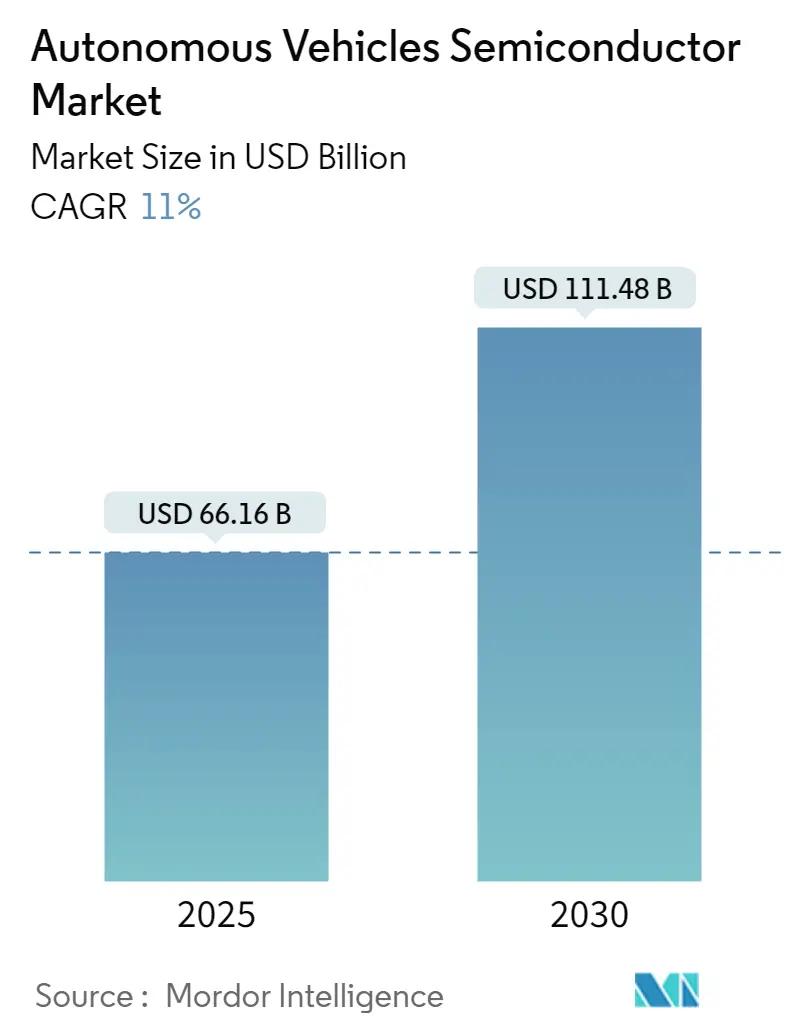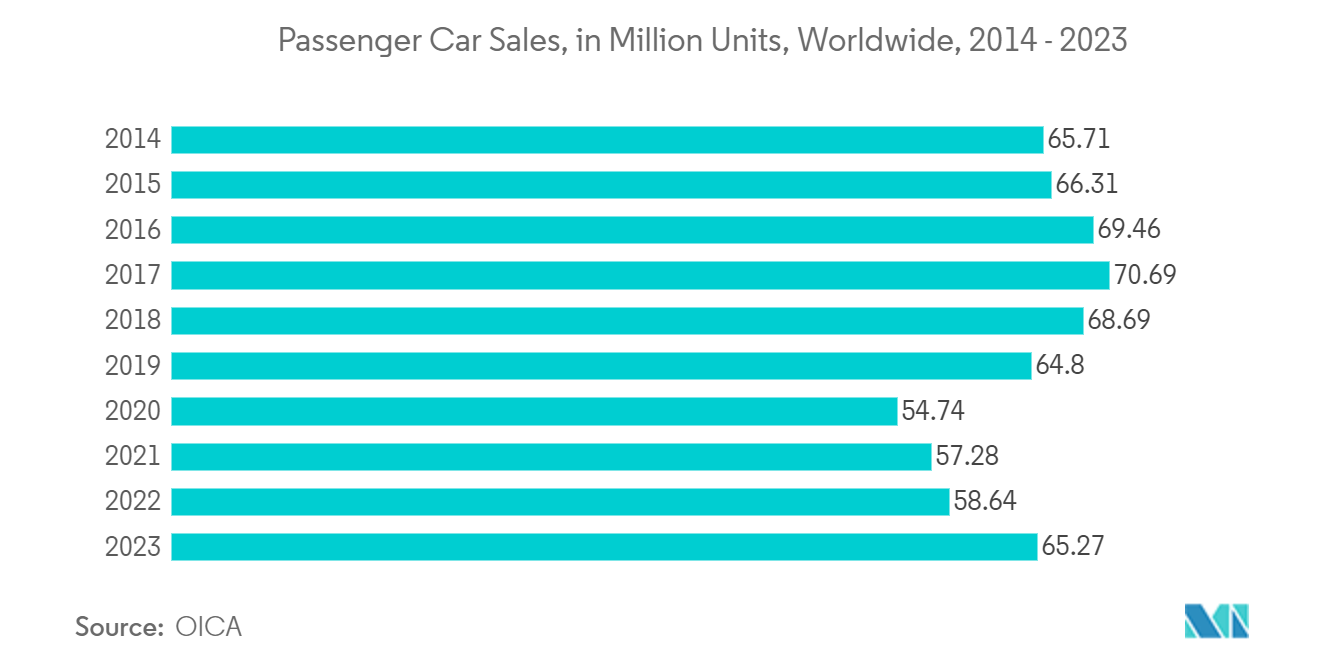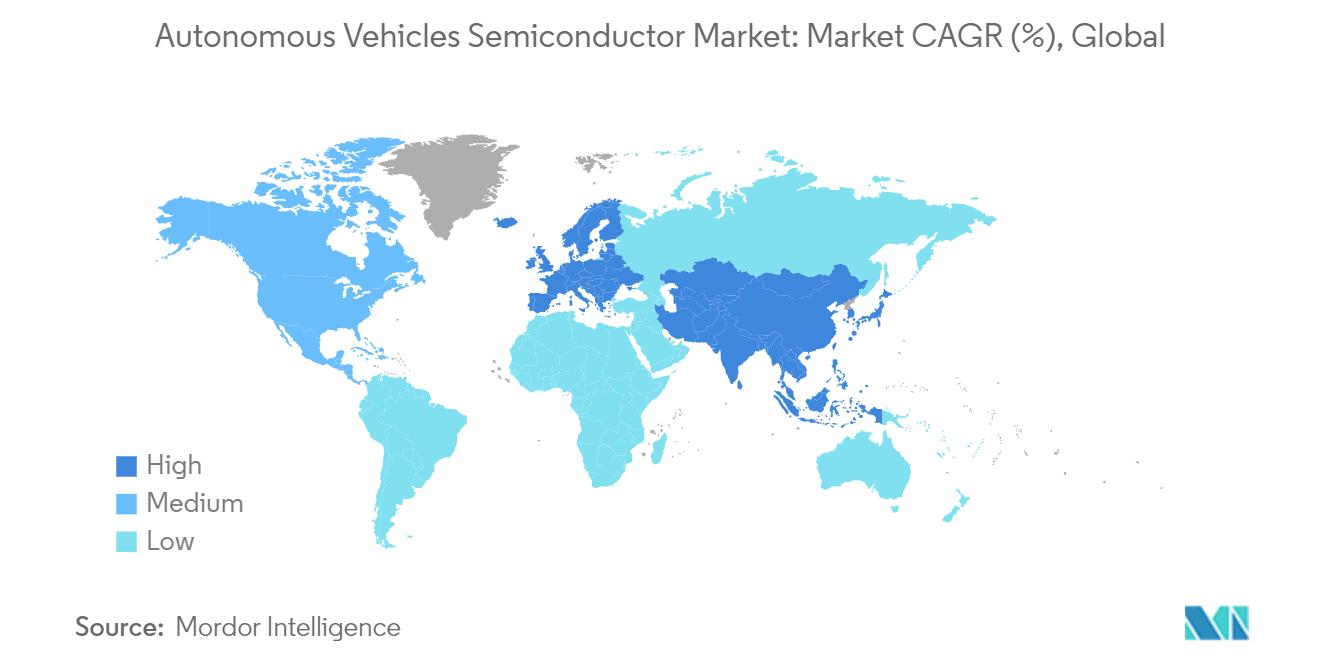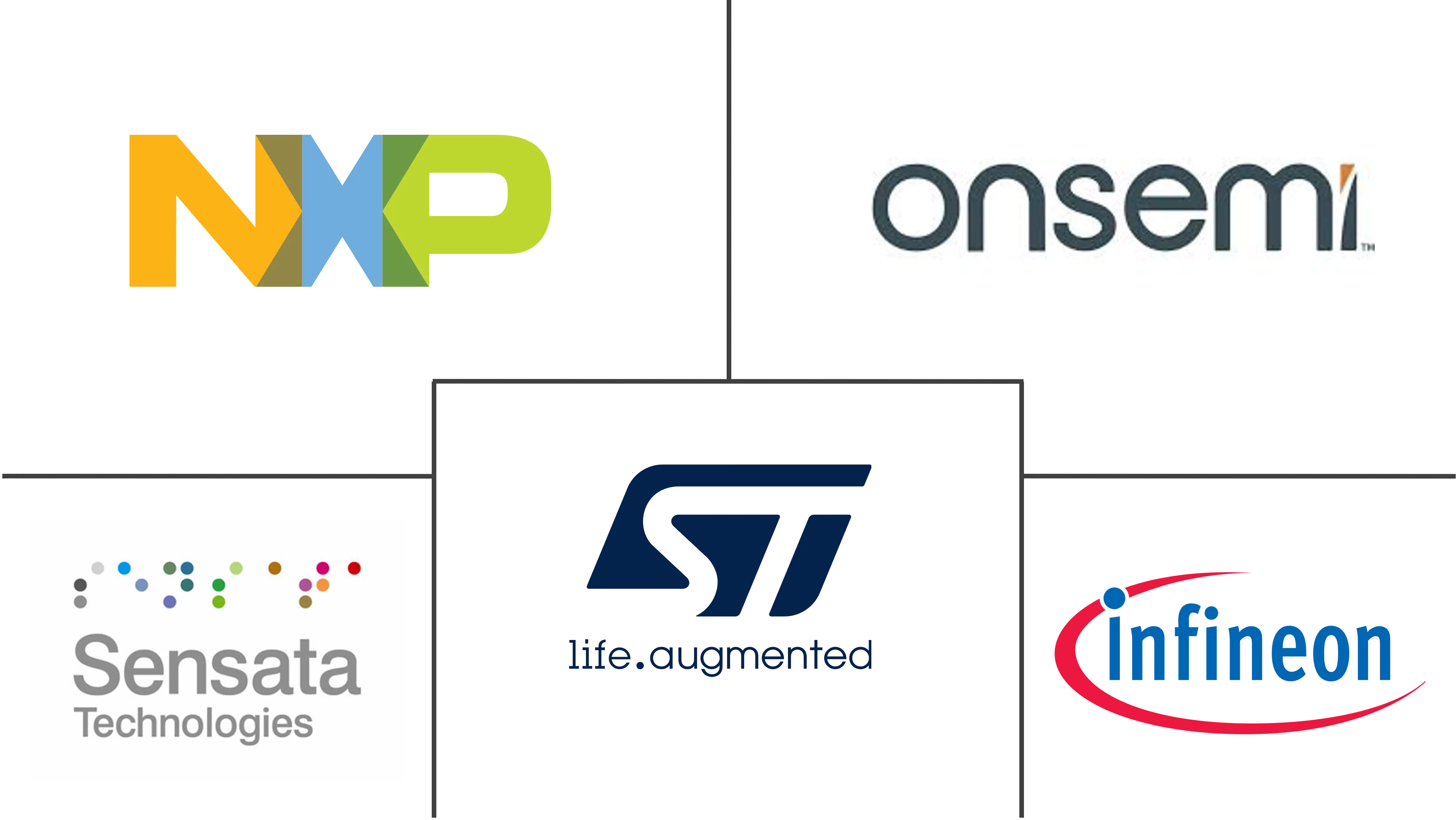Autonomous Vehicles Semiconductor Market Size and Share

Autonomous Vehicles Semiconductor Market Analysis by Mordor Intelligence
The Autonomous Vehicles Semiconductor Market size is estimated at USD 66.16 billion in 2025, and is expected to reach USD 111.48 billion by 2030, at a CAGR of 11% during the forecast period (2025-2030).
- The automotive industry, a leader in technological advancements, is now pivoting towards developing autonomous and connected vehicles. As vehicles become more intelligent and less dependent on human intervention, technologies such as vehicle-to-vehicle (V2V) and vehicle-to-everything (V2X) are becoming increasingly vital. These technologies enable the swift exchange of information through low-latency, high-bandwidth, and reliable connections, accelerating the move towards fully autonomous driving. This technological shift is simultaneously driving a heightened demand for semiconductors.
- The rise of next-generation vehicles highlights the indispensable role of integrated semiconductor chips. Far from being mere components, these chips are instrumental in transforming vehicle operations, interactions, and their awareness of the environment. With vehicles' increasing autonomy and interconnectedness, semiconductor chips are evolving to facilitate collaborative tasks, thereby enhancing safety, efficiency, and the overall driving experience.
- The rise of autonomous vehicles is reshaping the automotive landscape. A typical modern car houses fewer than 1,500 semiconductor chips, but newer electric vehicles with autonomous features can boast up to 3,500 chips. In the foreseeable future, semiconductors are vital for advanced applications, including advanced driver-assistance systems (ADAS), connectivity modules, and extensive sensor networks encompassing LiDAR, radar, and camera systems.
- Artificial intelligence (AI) and machine learning (ML) are central to autonomous driving, allowing vehicles to decode sensor data, make informed decisions, and adapt to their surroundings. Creating specialized AI chips, like Nvidia's Xavier and Tesla's Full Self-Driving (FSD) chip, underscores the significance of high-performance computing in this arena. These chips, crafted for deep learning tasks, are essential for object detection, path planning, and instantaneous decision-making functions. The fusion of next-gen materials, AI, and IoT technologies is poised to accelerate the growth of the automotive semiconductor market.
- Yet, the complexity of autonomous driving systems demands a seamless integration of diverse sensors, processors, and software. Ensuring these systems are reliable across varied and challenging conditions is a formidable technical hurdle. However, these challenges also present vast opportunities for innovation and market growth. As the industry evolves, semiconductors are set to be pivotal in realizing the vision of autonomous driving, enhancing the safety and efficiency of modern transportation systems.
Global Autonomous Vehicles Semiconductor Market Trends and Insights
Passenger Vehicle Segment to Hold Significant Market Share in the Autonomous Vehicles Semiconductor Market
- Technological advancements have propelled the evolution of autonomous passenger vehicles. A pivotal innovation reshaping the automobile industry is the incorporation of semiconductor technology. Presently, these vehicles boast an array of sensors, from sophisticated smart cameras to advanced lidars, all powered by robust semiconductor chips that enhance automotive efficiency.
- Autonomous vehicles stand to reshape the automotive landscape, unlocking fresh avenues for the Mobility as a Service (MaaS) sector and redefining transportation for people and goods. Crucially, they will reshape corporate expectations surrounding the passenger experience. With the advent of self-driving vehicles, the traditional role of the driver has faded. This shift, especially the removal of conventional driver controls, dramatically redefines the perception of a standard passenger car, influencing the trajectory of autonomous passenger vehicle growth.
- Furthermore, the global passenger car market is evolving, spurred by changing consumer preferences, emerging trends, and distinct regional dynamics. Data from OICA indicates that in 2023, global sales of passenger cars reached approximately 65.3 million, marking an 11.3% uptick from the prior year. China dominated as the leading regional market, accounting for close to 26.1 million units sold. As passenger car sales surge, consumers increasingly gravitate towards vehicles boasting advanced safety features and cutting-edge technologies, including autonomous driving and enhanced connectivity. This trend bodes well for the semiconductor industry's growth within the autonomous vehicle realm.
- Additionally, enhanced infotainment systems in passenger autonomous vehicles underscore another vital semiconductor application. Modern infotainment boasts features like voice assistants, real-time navigation, and in-car entertainment, all dependent on sophisticated processors and connectivity solutions. Industry giants such as Qualcomm and Intel provide automotive-grade processors, facilitating these features and ensuring a seamless user experience.
- Moreover, several passenger vehicle manufacturers are forging partnerships with semiconductor firms to bolster their prospects. A case in point: In February 2024, Infineon Technologies AG inked a Memorandum of Understanding (MoU) with Honda Motor Co., Ltd., marking the onset of a strategic alliance. Infineon has been designated as Honda's semiconductor partner, aligning its future product and technology trajectories. The two entities are also committed to ongoing discussions to ensure a stable supply, promote knowledge exchange, and collaborate on initiatives to accelerate the introduction of novel technologies to the market.

Europe to Exhibit a Significant Growth Rate in Autonomous Vehicles Semiconductor Market
- The European semiconductor sector is poised for significant growth, driven by surging demand for autonomous driving technology and the increasing acceptance of heavy-duty autonomous vehicles in public transport. Technological advancements, coupled with supportive regulatory frameworks, are paving the way for the widespread deployment of these vehicles.
- European nations are witnessing a surge in interest and investment in autonomous vehicles. Numerous companies are developing and implementing both semi-autonomous and fully autonomous heavy-duty vehicles across various sectors, including freight transportation, logistics, and public transit. Initiatives aimed at promoting sustainability and reducing carbon emissions further bolster the push for autonomous vehicle adoption. Given these dynamics, the heavy-duty autonomous vehicle market is set for substantial growth, reshaping the region's mobility landscape.
- Evolving regulations further buoy investor confidence in the European autonomous vehicle sector. In the UK, Parliament is deliberating a bill on autonomous vehicles, potentially allowing self-driving cars on roads by 2026. Meanwhile, Germany and France have greenlit level four autonomous cars in specific zones, and the EU is rolling out new regulations this year to define clear standards for these vehicles.
- Moreover, the European Union has imposed tariffs on electric vehicle imports from China, raising eyebrows about a possible reaction from Beijing. There's also heightened scrutiny on supplies of legacy chips. The EU's robust automotive sector has bolstered local chip giants like Infineon, NXP, and STMicroelectronics. Through its "Chips Act," the EU aims to strengthen Europe's strategic autonomy and security in the chip domain. To realize this vision, the EU has allocated a substantial EUR 3.3 billion (USD 3.69 billion) for research and innovation in the chip industry, a move anticipated to spur market growth.
- In January 2024, Škoda Auto underscored the importance of continuous technological innovation in the automotive realm, spotlighting its collaboration with onsemi. Their joint endeavors aim to elevate the Czech Republic's stature as a critical European semiconductor hub.
- Europe proudly hosted the most significant R&D initiative centered on driverless vehicles. The Prometheus Project, backed by a hefty EUR 749 million (USD 836.77 million) funding from the intergovernmental organization Eureka, saw participation from 20 European nations, including the UK, France, and Germany. The initiative garnered additional strength through endorsements from various automotive manufacturers and academic institutions.

Competitive Landscape
The autonomous vehicles semiconductor market is semi-consolidated, with global conglomerates and specialized players operating across various segments. While several large multinational companies dominate certain high-value segments, numerous regional and niche players contribute to the overall competition, making the market highly diverse. The automotive semiconductor market has undergone significant transformation due to the advent of modern cars equipped with autonomous driving capabilities.
Leading companies in the autonomous vehicles semiconductor market include Intel, On Semiconductor, Sensata Technologies, Qualcomm, NVIDIA, ST Microelectronics, Teledyne, NXP Semiconductor, and Others. These companies have established strong brand recognition and extensive global operations, enabling them to command significant market share. Their strengths lie in innovation, broad product portfolios, and strong distribution networks. These leaders often engage in strategic acquisitions and partnerships to maintain their competitive edge and expand their market reach.
To thrive in the autonomous vehicles market, it is essential for companies to prioritize innovation, invest in research and development, and consider strategic mergers and acquisitions. Leading industry players are making significant investments in research and development to explore the potential of semiconductor technology. Additionally, many organizations are pursuing strategic mergers and acquisitions to enhance their market positions and broaden their product offerings. Furthermore, this growth is being driven by the increasing demand for advanced driver assistance systems (ADAS), the rise of electric vehicles (EVs), and ongoing advancements in semiconductor technologies.
Autonomous Vehicles Semiconductor Industry Leaders
-
NXP Semiconductor
-
ST Microelectronics
-
Infineon Technologies
-
Sensata Technologies
-
On Semiconductor
- *Disclaimer: Major Players sorted in no particular order

Recent Industry Developments
- April 2024: Qualcomm has forged partnerships with Toyota and FAW Group's Hongqi, centering on its Snapdragon Ride autonomous driving chip. Furthermore, the company is in discussions with additional automotive manufacturers in China. The newly launched Snapdragon 8295 chip showcases significant performance upgrades, offering more than seven times the AI computing power of its forerunner. Presently, this cutting-edge chip is featured in renowned electric vehicle models, such as the Mercedes-Benz E-Class and a range of vehicles from Nio, Xpeng Motors, Zeekr, Xiaomi, and Leapmotor.
- April 2024: Valens Semiconductor and Black Sesame Technologies have teamed up to integrate A-PHY connectivity into the Huashan-2 A1000 chip, designed for autonomous driving. Additionally, they're working on embedding A-PHY into the Wudang C1200 platform, which focuses on intelligent vehicle cross-domain computing. Black Sesame Technologies is renowned for its development of chips and solutions that empower features like advanced driver-assistance systems (ADAS) and autonomous driving.
- March 2024: AMD and Sony Semiconductor Solutions (SSS) have teamed up to integrate AMD's cutting-edge adaptive computing technology into SSS's newest automotive LiDAR reference design. This collaboration aims to develop a powerful and efficient LiDAR solution specifically designed for autonomous vehicles, setting new standards in performance, reliability, and adaptability. The SSS LiDAR reference design equips automakers and automotive equipment suppliers to adeptly handle intricate driving situations and identify potential dangers with exceptional precision.
Global Autonomous Vehicles Semiconductor Market Report Scope
The advancements in autonomous driving technologies have increased the need for more sophisticated and high-performance semiconductors. These semiconductors play a vital role in supporting the complex functionalities essential for self-driving vehicles, including real-time data processing, sensor fusion, and artificial intelligence (AI) capabilities. For market estimation, the market study includes the analysis of various segments that includes level of autonomy, vehicle type, device and geography.
Autonomous vehicles semiconductor market is segmented by level of autonomy (L1, L2, L3, L4, and L5), vehicle type (passenger vehicle, commercial vehicle), device (radar, lidar, ultrasound, camera unit, processors, sensors, MCU), geography (North America, Europe, Asia Pacific, Rest of the World). The market sizes and forecasts are provided in terms of value (USD) for all the above segments.
| L1 |
| L2 |
| L3 |
| L4 |
| L5 |
| Passenger Vehicle |
| Commercial Vehicle |
| Radar |
| LiDAR |
| Ultrasound |
| Camera Unit |
| Processors |
| Sensors |
| MCU |
| North America |
| Europe |
| Asia |
| Middle East and Africa |
| Latin America |
| By Level of Autonomy | L1 |
| L2 | |
| L3 | |
| L4 | |
| L5 | |
| By Vehicle Type | Passenger Vehicle |
| Commercial Vehicle | |
| By Device | Radar |
| LiDAR | |
| Ultrasound | |
| Camera Unit | |
| Processors | |
| Sensors | |
| MCU | |
| By Geography*** | North America |
| Europe | |
| Asia | |
| Middle East and Africa | |
| Latin America |
Key Questions Answered in the Report
How big is the Autonomous Vehicles Semiconductor Market?
The Autonomous Vehicles Semiconductor Market size is expected to reach USD 66.16 billion in 2025 and grow at a CAGR of 11% to reach USD 111.48 billion by 2030.
What is the current Autonomous Vehicles Semiconductor Market size?
In 2025, the Autonomous Vehicles Semiconductor Market size is expected to reach USD 66.16 billion.
Who are the key players in Autonomous Vehicles Semiconductor Market?
NXP Semiconductor, ST Microelectronics, Infineon Technologies, Sensata Technologies and On Semiconductor are the major companies operating in the Autonomous Vehicles Semiconductor Market.
Which is the fastest growing region in Autonomous Vehicles Semiconductor Market?
Europe is estimated to grow at the highest CAGR over the forecast period (2025-2030).
Which region has the biggest share in Autonomous Vehicles Semiconductor Market?
In 2025, the North America accounts for the largest market share in Autonomous Vehicles Semiconductor Market.
What years does this Autonomous Vehicles Semiconductor Market cover, and what was the market size in 2024?
In 2024, the Autonomous Vehicles Semiconductor Market size was estimated at USD 58.88 billion. The report covers the Autonomous Vehicles Semiconductor Market historical market size for years: 2019, 2020, 2021, 2022, 2023 and 2024. The report also forecasts the Autonomous Vehicles Semiconductor Market size for years: 2025, 2026, 2027, 2028, 2029 and 2030.
Page last updated on:
Autonomous Vehicles Semiconductor Market Report
Statistics for the 2025 Autonomous Vehicles Semiconductor market share, size and revenue growth rate, created by Mordor Intelligence™ Industry Reports. Autonomous Vehicles Semiconductor analysis includes a market forecast outlook for 2025 to 2030 and historical overview. Get a sample of this industry analysis as a free report PDF download.



